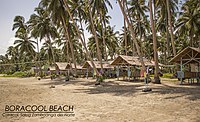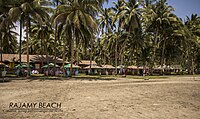Salug
This article needs additional citations for verification. (August 2014) |
Salug | |
|---|---|
| Municipality of Salug | |
 Map of Zamboanga del Norte with Salug highlighted | |
Location within the Philippines | |
| Coordinates: 8°06′27″N 122°45′27″E / 8.1075°N 122.7575°E | |
| Country | Philippines |
| Region | Zamboanga Peninsula |
| Province | Zamboanga del Norte |
| District | 3rd district |
| Barangays | 23 (see Barangays) |
| Government | |
| • Type | Sangguniang Bayan |
| • Mayor | William D. Maribojoc |
| • Vice Mayor | Saul L. Maraon |
| • Representative | Ian Amatong |
| • Municipal Council | Members |
| • Electorate | 22,765 voters (2022) |
| Area | |
• Total | 206.60 km2 (79.77 sq mi) |
| Elevation | 50 m (160 ft) |
| Highest elevation | 282 m (925 ft) |
| Lowest elevation | 0 m (0 ft) |
| Population (2020 census)[3] | |
• Total | 32,134 |
| • Density | 160/km2 (400/sq mi) |
| • Households | 7,558 |
| Economy | |
| • Income class | 3rd municipal income class |
| • Poverty incidence | 51.28 |
| • Revenue | ₱ 153.2 million (2020) |
| • Assets | ₱ 196.1 million (2020) |
| • Expenditure | ₱ 139.3 million (2020) |
| • Liabilities | ₱ 42.23 million (2020) |
| Service provider | |
| • Electricity | Zamboanga del Norte Electric Cooperative (ZANECO) |
| Time zone | UTC+8 (PST) |
| ZIP code | 7114 |
| PSGC | |
| IDD : area code | +63 (0)65 |
| Native languages | Subanon Cebuano Chavacano Tagalog |
| Website | salug |
Salug, officially the Municipality of Salug (Cebuano: Lungsod sa Salug; Subanen: Benwa Salog; Chavacano: Municipalidad de Salug; Tagalog: Bayan ng Salug), is a 3rd class municipality in the province of Zamboanga del Norte, Philippines. As of the 2020 census, it had a population of 32,134 people.[3]
History
[edit]The municipality of Salug was established by virtue of Republic Act No. 2510 enacted on June 21, 1959, upon separation of eleven barrios of Liloy, with Barrio Mucas the seat of government.[5][6]
Araw ng Salug (Salug Day) is annually celebrated on the 18th day of September.[citation needed]
Salug reduced its territory upon the creation of the municipality of Godod by virtue of Batas Pambansa Blg. 146 issued on February 8, 1982.[5][7]
Mayors' protest
[edit]On December 28, 2007, Salug Mayor Jesus Lim, president of the Zamboanga del Norte Mayors’ League, led 20 mayors of Zamboanga del Norte who protested the Department of Justice's incarceration of former congressman Romeo Jalosjos. Flags in their respective towns were flown at half mast and black ribbons were displayed at town halls.[citation needed]
Geography
[edit]Municipality of Salug is bounded on the south by the municipality of Godod the north-west by Liloy, to the east by the municipality of Leon B. Postigo, and to the north by Sindangan Bay.
Climate
[edit]| Climate data for Salug, Zamboanga del Norte | |||||||||||||
|---|---|---|---|---|---|---|---|---|---|---|---|---|---|
| Month | Jan | Feb | Mar | Apr | May | Jun | Jul | Aug | Sep | Oct | Nov | Dec | Year |
| Mean daily maximum °C (°F) | 29 (84) |
30 (86) |
30 (86) |
31 (88) |
30 (86) |
29 (84) |
29 (84) |
29 (84) |
29 (84) |
29 (84) |
29 (84) |
29 (84) |
29 (85) |
| Mean daily minimum °C (°F) | 23 (73) |
23 (73) |
23 (73) |
24 (75) |
25 (77) |
25 (77) |
24 (75) |
24 (75) |
25 (77) |
25 (77) |
24 (75) |
23 (73) |
24 (75) |
| Average precipitation mm (inches) | 96 (3.8) |
79 (3.1) |
117 (4.6) |
127 (5.0) |
239 (9.4) |
301 (11.9) |
286 (11.3) |
283 (11.1) |
255 (10.0) |
272 (10.7) |
188 (7.4) |
115 (4.5) |
2,358 (92.8) |
| Average rainy days | 17.3 | 16.0 | 19.7 | 21.6 | 29.0 | 29.0 | 29.7 | 29.1 | 28.5 | 28.9 | 25.3 | 20.0 | 294.1 |
| Source: Meteoblue[8] | |||||||||||||
Salug falls within the third type of climate wherein the seasons are not very pronounced. Rain is more or less evenly distributed throughout the year. Because of its tropical location the municipality does not experience cold weather. Neither does it experience strong weather disturbances due to its geographical location (being outside the typhoon belt) and also because of the mountains that are surrounding the municipality.
Barangays
[edit]
Salug is politically subdivided into 23 barangays. Each barangay consists of puroks while some have sitios.
- Bacong
- Balakan
- Binoni
- Calucap
- Canawan
- Caracol
- Danao
- Dinoan
- Dipolod
- Fatima (Pogan)
- Ipilan
- Lanawan
- Liguac
- Lipakan
- Mucas
- Pacuhan
- Poblacion (Salug)
- Poblacion East
- Pukay
- Ramon Magsaysay (Tugop)
- Santo Niño
- Tambalang
- Tapalan
Demographics
[edit]| Year | Pop. | ±% p.a. |
|---|---|---|
| 1960 | 13,486 | — |
| 1970 | 28,688 | +7.83% |
| 1975 | 32,709 | +2.67% |
| 1980 | 39,088 | +3.63% |
| 1990 | 25,702 | −4.11% |
| 1995 | 28,411 | +1.90% |
| 2000 | 28,914 | +0.38% |
| 2007 | 29,960 | +0.49% |
| 2010 | 31,157 | +1.44% |
| 2015 | 32,204 | +0.63% |
| 2020 | 32,134 | −0.04% |
| Source: Philippine Statistics Authority[9][10][11][12] | ||
Salug Municipality is predominantly Christian with Philippine Independent Church or Aglipayan and Roman Catholics constitutes the majority of the Christians. Salugnon is composed of Visayan speaking locals and the minorities that compose of the lumad or aborigine Subanon tribe.
Language
[edit]Cebuano and Subanon are majority spoken languages. The majority of the population can speak and understand English.[citation needed]
Tourism
[edit]-
Boracool Beach
-
Rajamy Beach
Economy
[edit]Poverty incidence of Salug
10
20
30
40
50
60
70
2006
54.80 2009
60.19 2012
49.47 2015
49.65 2018
49.39 2021
51.28 Source: Philippine Statistics Authority[13][14][15][16][17][18][19][20] |
Transportation
[edit]The Integrated Bus Terminal, located at the center of the municipality, serves short- and long-distance trips connecting other municipalities, cities in Zamboanga del Norte and neighboring provinces. The public modes of transportation within the municipality are sikad-sikad and habal-habal and pedicabs. Jeepneys, van, and bus Rural Transits are available for long-distance travels.
Seaport
[edit]The Port of Liloy is located 30 minutes[vague] away from the Municipality of Salug facing the Sindangan Bay It serves the cargo port for transporting products to and from Zamboanga City, Sindangan and Cebu.
Airports
[edit]The main airport is Dipolog Airport, located in the City of Dipolog, a 3+1⁄2-hour drive from the Poblacion. There is also a neighboring community airport in Liloy but it serves only private and government aircraft for official visits in the adjacent areas.
Government
[edit]Elected officials
[edit]Members of the municipal council (2019–2022):[21]
| Position | Name | Party | |
|---|---|---|---|
| Municipal Mayor | Melodie J. Tolin | PDP–Laban | |
| Vice Mayor | William D. Maribojoc | APP | |
| Sangguniang Bayan Members |
Jose Reil P. Lagare | APP | |
| Jonathan R. Balucos | APP | ||
| Richard P. Tomarong | APP | ||
| Allan D. Saldia | APP | ||
| Gerardo T. Literatus | APP | ||
| Emedio J. Galleposo | APP | ||
| Mercedario N. Pamil | PDP–Laban | ||
| Salatiel S. Dialo | APP | ||
Municipal officials (2016-2019):
- Mayor: Jeffrey T. Lim
- Vice Mayor: William D. Maribojoc
- Councilors:
- Jonathan R. Balucos
- Rebecca L. Baguio
- Mercedario N. Pamil
- Gerardo T. Literatus
- Allan D. Saldia
- Salatiel S. Dialo
- Oscar M. Acas
- Edgar A. Sultan
- Cerelino Mercado - ABC President
References
[edit]- ^ Municipality of Salug | (DILG)
- ^ "2015 Census of Population, Report No. 3 – Population, Land Area, and Population Density" (PDF). Philippine Statistics Authority. Quezon City, Philippines. August 2016. ISSN 0117-1453. Archived (PDF) from the original on May 25, 2021. Retrieved July 16, 2021.
- ^ a b Census of Population (2020). "Region IX (Zamboanga Peninsula)". Total Population by Province, City, Municipality and Barangay. Philippine Statistics Authority. Retrieved 8 July 2021.
- ^ "PSA Releases the 2021 City and Municipal Level Poverty Estimates". Philippine Statistics Authority. 2 April 2024. Retrieved 28 April 2024.
- ^ a b "Executive Summary (2015)" (PDF). Commission on Audit. Government of the Philippines. 2015. Retrieved March 23, 2023.
- ^ "Republic Act No. 2510". Supreme Court E-Library. Government of the Philippines. June 21, 1959. Retrieved March 23, 2023.
- ^ "Executive Summary (2018)" (PDF). Commission on Audit. Government of the Philippines. 2018. Retrieved March 23, 2023.
- ^ "Salug: Average Temperatures and Rainfall". Meteoblue. Retrieved 30 April 2020.
- ^ Census of Population (2015). "Region IX (Zamboanga Peninsula)". Total Population by Province, City, Municipality and Barangay. Philippine Statistics Authority. Retrieved 20 June 2016.
- ^ Census of Population and Housing (2010). "Region IX (Zamboanga Peninsula)" (PDF). Total Population by Province, City, Municipality and Barangay. National Statistics Office. Retrieved 29 June 2016.
- ^ Censuses of Population (1903–2007). "Region IX (Zamboanga Peninsula)". Table 1. Population Enumerated in Various Censuses by Province/Highly Urbanized City: 1903 to 2007. National Statistics Office.
- ^ "Province of Zamboanga del Norte". Municipality Population Data. Local Water Utilities Administration Research Division. Retrieved 17 December 2016.
- ^ "Poverty incidence (PI):". Philippine Statistics Authority. Retrieved December 28, 2020.
- ^ "Estimation of Local Poverty in the Philippines" (PDF). Philippine Statistics Authority. 29 November 2005.
- ^ "2003 City and Municipal Level Poverty Estimates" (PDF). Philippine Statistics Authority. 23 March 2009.
- ^ "City and Municipal Level Poverty Estimates; 2006 and 2009" (PDF). Philippine Statistics Authority. 3 August 2012.
- ^ "2012 Municipal and City Level Poverty Estimates" (PDF). Philippine Statistics Authority. 31 May 2016.
- ^ "Municipal and City Level Small Area Poverty Estimates; 2009, 2012 and 2015". Philippine Statistics Authority. 10 July 2019.
- ^ "PSA Releases the 2018 Municipal and City Level Poverty Estimates". Philippine Statistics Authority. 15 December 2021. Retrieved 22 January 2022.
- ^ "PSA Releases the 2021 City and Municipal Level Poverty Estimates". Philippine Statistics Authority. 2 April 2024. Retrieved 28 April 2024.
- ^ "2019 NLE List of Elected City/Municipal Candidates" (PDF). Commission on Elections (Philippines).






